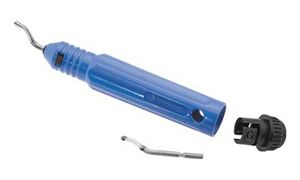Cutting Aluminium Composite
How to Cut Aluminium Composite
Aluminium composite may be one of the most popular materials in sign making, but cutting it isn't always straightforward. The versatility and relative inexpensiveness of aluminium composite has long rendered it a favourite among sign makers. The rust and waterproof nature of the aluminium composite makes it a long-lasting choice for usage outdoors, as does the smooth finish, and the high-quality durability has contributed to the market demand widening over the past few decades.
The material itself is comprised of two layers of aluminium divided by a non-aluminium substance, such as a thin layer of resin. Cutting through all three without damaging the ends can prove to be a difficult task. Workable for a number of projects, aluminium composite can be used in everything from large road signs to small flat signs and even lettering. But while cutting it may appear straightforward, the process can often result in burred edges, uneven corners and mess. It can be a particularly time-consuming undertaking if done by hand as well, taking about half an hour to cut through 2.5metres. But many sign makers are hesitant to invest in machinery that can take up space and become expensive, especially if the workload is relatively light.
Sign Update caught up with exhibitors and delegates at the UK Sign & Digital Show 2013 to find out how sign makers are tackling the task of cutting aluminium composite. Several of you told us about using a Treadle Guillotine, which we'll explore in more detail. Some are using a steel or aluminium ruler with a stainless steel cutting edge, some choose a wide format cutting bar, while others rely on a circular sawbench, or a circular saw used on a separate bench. Every sign maker's needs are different, depending on budget, and the amount of inventory being shifted, which results in so many different approaches to cutting sheets.
So is there a secret to cutting Dibond and similar aluminium composite panels in a cost-effective, low-hassle way? Sign Update chats with three experts to get the scoop on common cutting problems, as well as technology and techniques to overcome them.
A simple approach
Paul Hughes boasts over 20 years of experience in the industry, and owns Sign Making Tools (www.signmakingtools.co.uk), a sign and vehicle wrapping tools supplier based in Telford. For Hughes, the trick to successfully cutting aluminium lies in going back to the basics.
"A lot of people don't realise you can cut it with a knife," he explains. "People think you need a circular saw or table saw, but you can actually cut it with a safety edge using a knife."
When cutting aluminium, the sharp tip of the knife is the key to scoring a defined line across the surface. For this reason, knives such as a heavy duty 18mil snap off blade utility knife are ideal. "I use this one because you break the tip quite regularly when you're cutting aluminium, but that's the bit you want to use. With a snap off top of blade, you can snap a new tip off very easily," he says.
A clean cut using just a knife requires a little technique and practice. Brute force does not necessarily result in faster cutting, but instead more damage to the product and edges that will require even more time to fix and sand down. A common mistake is trying to cut through all three layers at once, a tactic that will result in burred edges and curled lips. "What you have to do is score through the top layer of the aluminium," says Hughes, advising that this will make the process of working through all three layers easier. Once scored, you can snap the piece off for a clean finish. To tidy up edges, he suggests using a Surform shaver tool, deburring tool or simple corner rounder.
There are two grades of aluminium composite, and the tools used on it should reflect which one is being cut. "There is construction grade, or there is a lighter hoarding grade, which is even easier to cut because the aluminium is thinner," explains Hughes. "If you cut aluminium semi-infrequently and in small quantities, there are various tools you can use to do it manually."
Panel saws or table saws are obvious choices for hand-cutting, although they are not ideal for cutting larger sheets. Similarly a circular table saw may be able to cut through the material easily, but managing a bigger sheet can be difficult especially if you're on your own. "You can't manage the board weight-wise unless you look for a top of the range model with a shelf built in," says Hughes.
While Paul may prefer the simplicity and craftsmanship of hand-cutting, ultimately the decision comes to the job at hand. The decision to invest in machinery is one that rests on the workload. "It all comes down to how much you're doing," says Hughes. "If you're gearing up to do lots, you need to put the right equipment into place."
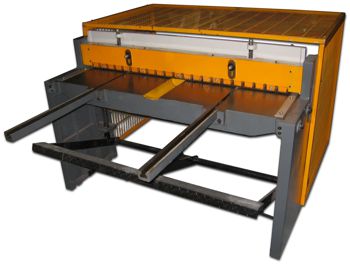
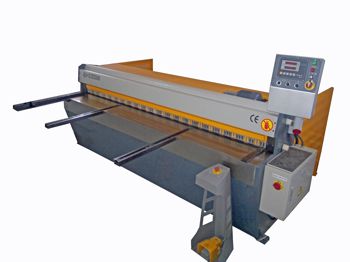
Straight-edged success
Bernard Van Cleven, Mantech (U.K.) Ltd. (www.mantechmachinery.co.uk), shares his insight into how a mechanical guillotine can help even out the process and create straight, flawless edges.
"Cutting is about shearing and breaking of material - 1/3 is the shearing, and 2/3 is breaking the material," says Van Cleven enthusiastically.
He is describing the technique with which to operate a mechanical guillotine without damaging the composite, a process that could make fast work of several orders. "Imagine a pair of scissors, if you will. If you can keep the blades closer together you have a quicker cutting action which results in less deformation of the material," he explains.
For high-volume sign makers looking to increase production flow whilst still producing quality cuts, a mechanical guillotine may be the perfect answer. That said, these benefits come at a price. A 2550mm motorized model costs around £8300, but the power provides a clean finish with minimal curling. For the lower end of a budget, the Treadle guillotine can be powered manually by using a pedal, and offers a more attractive price point to sign makers who produce on a small scale. The shearing action can cause narrower offcuts to curl, so some finishing and refining is needed. According to Van Cleven, a trick to minimizing this is keeping the bottom blade flat while paying close attention to the angle of the top blade. "With the cutting action, keep the angle as minimum as possible - no more than 1.5 degrees," he explains. The Treadle is unsuited to larger 2500mm x 1250mm aluminium composite panels, and is much more effective with smaller pieces of a maximum 1320mm width. Again, not using the proper angle can result in curling, so blades should be positioned at an angle less than 1.5 degrees.
Picking the perfect tool
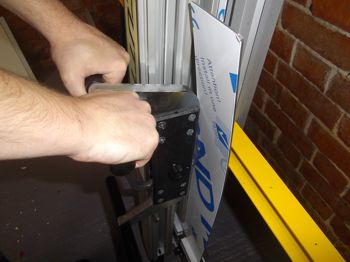
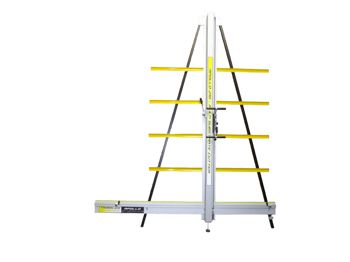
Alex McLean, Managing Director of FTC (UK) Ltd (www.ftcuk.com), oversees the manufacturing of Trimalco cutters. According to McLean, the single-biggest mistake one can make when trying to cut aluminium is using the wrong blade.
When cutting aluminium, sign makers may use a chop saw for extrusion and turn to a panel saw for sheets. According to McLean, if there is a struggle or damage being done to the product, the chances are it's down to the wrong blade being used, not ineffective technique. "It is essential to use a blade designed for cutting aluminium," he says.
The variety of options available means choosing the right product depends on the type of aluminium composite, but blades should always be a key consideration. Unlike other materials, the composite responds more to the tool than the technique. "Cutting aluminium in all its forms is purely down to using the correct tools," says McLean. Sign Update caught a demonstration of how to effectively use the right tools at the Trimalco stand at the UK Sign & Digital show in April. The blade was set just deep enough to cut through the top layer, which was roughly 0.3mm, or about 10% of the overall thickness. After the initial cut the piece was snapped straight off, which resulted in a clean finish.
There can be a lot of trial and error on a sign maker's part to establish exactly what works and what doesn't. For example, products such as the Europa Cutter Rails were not designed to cut aluminium composite panels, yet many of McLean's customers do just that. "The results are surprisingly good. It ruins the blade, but at £9.00 for 100 blades it doesn't appear to be an issue," he says.
Key areas of difficulty when cutting aluminium include mess, the noise created by large machinery, the need to remove or correct sharp edges and contamination. While some products like the Trimalco line are designed to provide clean cuts that minimize fall out, for other saws, the simple solution of housing the saw in a separate room from your laminator and printer can help reduce the debris, keeping your primary workspace clear. Regarding sharp edges, McLean notes that the Apollo Multi-substrate cutter uses two wheels to slice through aluminium composite panels and sheet aluminium, reducing the need for further finishing and without contamination.
An all-in-one solution
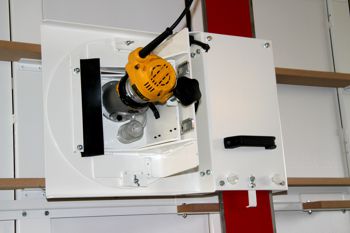
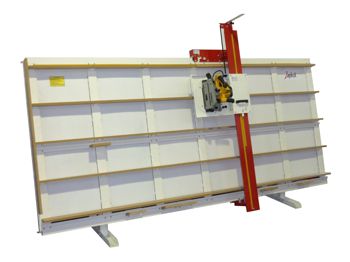
Keith, Managing Director of Zapkut (www.zapkut.co.uk), manufactures vertical panel saws to cut aluminium composites such as Dibond. Used in conjunction with a router, this method makes light work of cutting even a fulllength, 3 metre Dibond sheet.
According to Keith, the resurgence from economic recession is imminent, and now is the time to invest in products such as a vertical panel saw to make light work of cutting aluminium composite before demand starts to swiftly increase.
"Sign makers have relied on material suppliers for cutting for free, but this won't be the case for too much longer," he says. "For many, they'll simply wake up and realise they're paying a lot of money for the cutting service that they could be doing themselves."
With machines in the middle of the range priced at under £3,000, the vertical panel saw is attractively priced. The addition of a floating head router runs just over £500 extra, giving sign makers benefits that are, according to Keith, both affordable and instrumental in creating clean, quality cuts.
"The router cutter protrudes from the base plate by the depth that you want to go into the composite," he explains. "That base plate of the router presses against the surface of the material, so you've got that constancy of depth. This allows for very accurate machining - to within 0.1mm." The router depth can be set very precisely using the twist dial arrangement, enabling sign makers to run the column along the sheet or across its width by moving either the column or the router head. This enables the operative to handle sheets without assistance. A vertical panel saw is designed to cut across both the width and length of a sheet, and unlike other tools doesn't apply force to the cut which can often result in rounded edges.
As well as being able to make tricky bevel cuts, the saw and router when used to- gether are ideal for making light boxes, commonly used to backlight signage. The Dibond composition typically is 0.3mm skin of aluminium either side of 2.4mm polyethylene, can be easily cut and manipulated with minimal skill or technique to create one. "You machine out the front face, and most of the polyethylene in a V shape, at a 90 degree angle, giving you the opportunity to fold it. If you run a line right along each edge, you'll have a corner piece," says Keith. Once folded up, the whole piece comes together, and the corners can then be easily glued.
For Keith, a vertical panel saw is an intrinsic part of a sign maker's arsenal. "It's simply a well-priced, easy way of cutting sheet material, and that is going to become more of a requirement from sign makers as we come out of recession."

